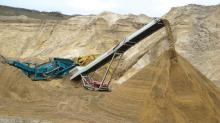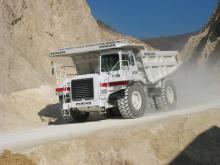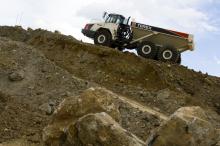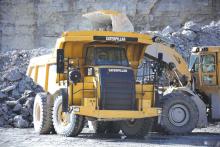
Despite the higher initial cost, rigid dump trucks still offer lower costs and higher productivity in the long term
Articulated dump trucks and conveyors may be grabbing the headlines when it comes to lower investment costs and lower emissions, respectively, but rigid dump trucks (RDTs) still deliver best value. That is according to
"When you add up all of the costs, RDTs do deliver the lowest cost per tonne," he explained. "The size of machine is a site specific choice, but the higher productivity, lower operating costs and durability of an RDT compared to an articulated truck outweigh any disadvantages." According to Walker, RDTs also offer significant safety advantages in the form of a canopy over the operator's cab and greater stability while moving around the quarry.
Nonetheless, he added that there is a minority of quarries where conditions are too poor for RDTs. "In quarries where the haul roads are too steep or too rough, or if the benches are too narrow for an RDT to manoeuvre, ADTs may be better suited to the existing conditions," he explained. "But I think it is better to adjust the quarry design to suit RDT use. The cost involved in draining the site, reprofiling haul roads or widening the benches would be repaid by the higher productivity and lower costs of RDTs.
"Sand and gravel quarries and those producing lighter materials are a different matter, but the benefits hold true for most hard rock quarries. There is only a small minority that could not benefit from RDTs." Cat is looking to find a site where the actual benefit could be quantified but, according to Walker, it has not yet found a site where it can "tie it down yet". But he said that the advantages and cost benefit is seen over a number of years and should be clear in three to four, and maybe even before that.
In the current economic climate, the lower purchase price could drive a short term trend towards ADTs but Walker is confident that companies looking at the long term will still opt for RDTs.
"In additional to the lower cost per tonne of operation, RDTs also have a higher resale value and can also be rebuilt to extend the service life well beyond that offered by an ADT," he said.
Added features
Walker said that future RDT developments are likely to deliver further productivity enhancements but there will be more emphasis on operating costs in terms of reduced fuel consumption and extended service intervals.
"The last stages of improvements focused on operator comfort and this is also likely to continue evolving," he said.
Cat has an off-highway track simulator for training, which until now has mostly been used by the mining sector, but Walker expects growth in this service to come from the quarry market as customers look to get the most from their machines and train new operators. "It is much safer to train a new driver in a simulator before they drive the real thing," he said.
Safety is still a major driver when it comes to specifying a new RDT and Walker said that a lot of customers are concerned with access and egress from these machines as this is the most common cause of accidents. "Through customer input we have introduced integrated staircases and ladders on the new F series but we are always working on ways to further enhance the safe use of our machines," he explained.
Market share
When asked if the larger ADTs in development will take market share from the RDT market, Walker said that customers with a strong cost control are likely to still opt for RDTs.
Although RDTs are considered more cost effective when it comes to hauling hard rock, ADTs do still have a place in earthworks within quarries, such as the overburden stripping or restoration phases.
On the subject of conveyors as an alternative hauling option, Walker said that he has seen some quarries switch from truck fleets to conveyors. "But there is considerable time and cost involved in setting them up and in the event of a break down, the whole production process in a quarry stops," he said. "If one of the trucks breaks down, then production may not be as efficient as normal but it will still continue and this will always be an import consideration for quarry operators."
Rolling with the routine
While RDTs have the potential to deliver the lowest cost per tonne hauling solution, achieving this requires a good routine maintenance programme, according to Cat product support supervisor Terry Miller.
"Following the inspection guidelines and maintenance intervals detailed in your truck's operation and maintenance manual is the way to keep operating costs down, and it's the main way to avoid mechanical failures that result in costly unplanned downtime and lost production," explained Miller. "Proper routine maintenance coupled with good operating practices delivers the lowest cost per tonne." According to Miller, routine maintenance is a shared responsibility of maintenance technicians and truck operators. The pre-shift truck inspection conducted by the operator is both a safety inspection and a maintenance inspection. Ideally, the operator would use a checklist for the walk around inspection to make sure coolant levels and tyres are regularly checked.
"The problems that the operator detects and reports during the walk around inspection and during the operating shift often can avert costly mechanical failures," he said. "Regardless of who is conducting inspections, monitoring machine health or performing routine maintenance, the operation and maintenance manual for your truck provides details that can guide those actions." Miller recommends performing tyre inspections daily and checking tyre inflation every 50 operating hours or at least weekly. "Always obtain the proper tyre inflation pressure from your tyre supplier," he said. "Low tyre pressure can be hazardous, because it affects truck handling and braking. Additionally, low inflation pressure reduces load carrying capability, allows the tyre to heat up quickly and increases rolling resistance. The result is accelerated tyre wear and higher haulage costs.
Cat also recommends regular sampling and analysis of oils in major truck systems, such as the engine crankcase, torque converter and transmission, differential and final drives, steering system, and front wheels. "Monitoring the condition of these oils helps establish appropriate change intervals and helps identify problems before they lead to mechanical failures," explained Miller. "Fluids analysis is an integral part of machine health monitoring and machine management. Such a programme can lower operating costs significantly and increase mechanical availability of your trucks." Miller also recommends regular washing of the truck to allow for structural checks of the frame and body of the RDT and should be undertaken every 1000 hours or six months. The suspension cylinders or struts should also be checked on a regular basis and Miller suggests an interval of 500 hours for this.









